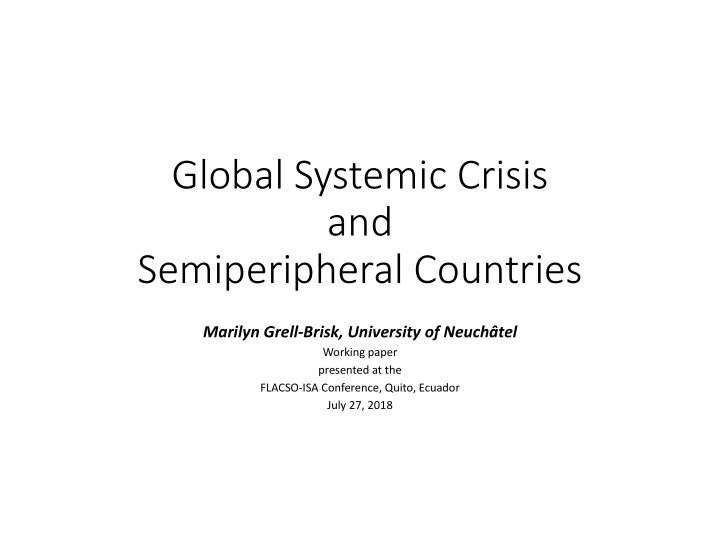



Global Systemic Crisis and Semiperipheral Countries Marilyn Grell-Brisk, University of Neuchâtel Working paper presented at the FLACSO-ISA Conference, Quito, Ecuador July 27, 2018
Helpful Readings On the method and logic of global economic stratification Arrighi, Giovanni and Jessica Drangel. 1986. “Stratification of the World-Economy: An Exploration of the Semi-Peripheral Zone.” Review (Fernand Braudel Center) X(1):9–74. On world-system criticisms and response from Immanuel Wallerstein Prologue of 2003 Edition of Wallerstein, Immanuel. 1974. The Modern World System: Capitalist Agriculture and the Origins of the European World-Economy in the Sixteenth Century, Vol. 1. New York: Academic Press.
Approach Ø A question of approach • Wallerstein conceptualization of semi-periphery • structural inequality • how do you measure global economic Core stratification? Semiperiphery Periphery
Data and Method Ø Arrighi and Drangel • Percent of world population as a function of log GNI per capita (power based on benefits of world division of labor) • Percent of world population as a function of military expenditure (power based on global military capacity) • Period of study: 1990 to 2015 • Time not geographic space held constant
Classic Trimodal World-Economic System 18% 16% Core Percentage of Total World Population 14% Semiperiphery 12% Periphery 10% peripheral semiperipheral core economic zone economic zone 8% economic zone 6% 4% 2% 0% 2 3 4 5 1990 Log GNI Per Capita
Movement of Semiperipheral Countries
Movement of Semiperipheral Countries Country positions in the world-economy for the year 1990
Movement of Semiperipheral Countries Country positions in the world-economy for the year 2000
Unstable Global Economic Hierarchy
Unstable Global Economic Hierarchy
Dismantling of Classic Trimodal Distribution
New Global Economic Stratification Order Percentage of Total World Population 15% semiperipheral economic zone 10% 5% 0% 1 2 3 4 5 6 2015 Log GNI Per Capita
Concentration of global military power
Military-Economic Entanglements
Military Core and World-Economic Rank
Semiperipheral and Peripheral Cooperation Ø ALBA (Bolivarian Alliance for the Peoples of our America) • Antigua and Barbuda, Bolivia, Cuba, Dominica, Ecuador, Grenada, Nicaragua, St. Kitts and Nevis, St. Lucia, St. Vincent and the Grenadines, Venezuela Ø AFTA (ASEAN (Association of Southeast Asian Nations) Free Trade Area) § Brunei, Darussalam, Indonesia, Malaysia, Philippines, Singapore, Thailand; Vietnam, Laos, Myanmar; Cambodia Ø BRICS (Brazil, Russia, India, China, South Africa) Ø AIIB (Asia Infrastructure Investment Bank) Ø BRICS Banks (New Development Bank, Contingent Reserve Arrangement Ø BRI (Belt and Road Initiative formerly One Belt and One Road Initiative)
Semiperipheral and Peripheral Cooperation Ø Commodified Citizenship § exchange-value given to citizenship by linking a price to it § intensive expansion of capital into civic life Ø Transnationals § limited mobility based on citizenship laws § mobility facilitated by commodified citizenship Ø Semiperipheral/Peripheral mobility
Commodified Citizenship in Dominica Source: Data collected by the author for the period 1990-2015
Tianxia �� “ all under heaven” Tianxia Tixi : Shijie Zhidu Zhexue Daolun [The Tianxia System: A Philosophy for the World Institution] by Zhao Tingyang (2005) Ø Geographic Integration § all of the physical earth Ø Psychological Integration § all of the hearts of all the people in the world Ø Institutional Integration § one world political system and institution
End of Hegemony Ø Hegemony making Ø The consent of different subordinate groups that allow themselves to be led by a dominant group is absolutely necessary. Ø Deep global divisions
Enthusiasm Ø Forced cooperation Ø Forced submission
Further Reading Grell-Brisk, Marilyn. 2017. China and Global Economic Stratification in an Interdependent World. Palgrave Communications 3:17087 Grell-Brisk, Marilyn. 2018. Eluding National Boundaries: A case study of commodified citizenship and the transnational capitalist class. Societies 8(2) 35 Grell-Brisk, Marilyn. 2018 (forthcoming). Arrested Development? Sub-Saharan Africa in the Stratified World-Economy 1965-2015. Journal of Contemporary African Studies. Grell-Brisk, Marilyn and Christopher Chase-Dunn. 2019 ( forthcoming). Mind the Gap! Clustered Obstacles to Mobility in Core/Periphery Hierarchy. In Frontiers of Globalization Research: Theoretical and Methodological Approaches . 2 nd Edition . e.d. Ino Rossi. New York: Springer Karatasli, Sahan Savas. 2017. “The Capitalist World-Economy in the Longue Durée: Changing Modes of the Global Distribution of Wealth.” Sociology of Development 3(2):163–96. Wallerstein, Immanuel. 2003. The Decline of American Power . New York: The New Press.
THANK YOU www.marilyngrell.com
Recommend
More recommend